Learning artistic anatomy requires a lot of effort and work. Thus, many aspiring artists ask whether it is necessary to master anatomy to draw and paint human or animal figures. Let me shed more light on the subject.
Artistic anatomy is important if you want to realistically depict people or animals with your artwork. Without anatomical knowledge and its application, your drawings will remain at an amateur level. The lack of anatomical knowledge will show up in your work. By observing the human body externally, we cannot reveal its forms, nor the logic behind which these forms change as they move. Whether you work with traditional or digital tools and techniques to create fine artworks, illustrations, caricatures, comics, or cartoons, knowledge and application of artistic anatomy is essential.
In addition to anatomy, you also need to learn the application of perspective, constructive drawing techniques, tonal rendering, and the elements of artistic composition to create high-quality works of art.
The Subject of Artistic Anatomy
For figural drawing, artists need to understand the structure of the body. This includes the skeletal system with the joints, as well as knowledge of the muscles visible on the surface of the body, the skin, and the tissues under the skin.

Artistic anatomy does not deal with the muscles in the deeper layers, internal organs, and nervous system that do not affect the surface appearance of the human body. Although part of the vascular system is visible on the surface of the skin, it is of little importance in artistic anatomy.
Anatomy in art is important for the correct representation of human figures. Artists, therefore, study the structure and range of motion of the human body. The same goes for depicting animals.
Learning Artistic Anatomy the Right Way?
Anatomy used in art does not view the human body in the same way as medical anatomy. It is not necessary to know in detail all the parts of the body, it is enough to know only the parts and systems that affect our drawings. Internal organs and muscles that are not visible on the outer surface are not important.
The human body is a complex structure. The movement of individual body parts affects the whole body. Therefore, in addition to knowing the parts individually, we also need to know the connections.
The recommended way to learn anatomy is to study the shapes of the human body from the inside out, starting with the skeletal structure, which is the solid foundation of the body.
You need to learn how bones, joints, and muscles are connected. In addition, you need to study the movements of the body and the surface appearance of its shapes.
The best way to study the body is to divide it into units. I recommend the following method described by Professor Jenő Barcsay:
- The first unit contains the bones, joints, and muscles of the shoulder girdle, along with the arms and hands, their range of motion, and their external appearance. While on the subject, you may be interested in my article on drawing hands.
- The second unit is about the bones, joints, and muscles of the legs and feet with the pelvis, as well as the analysis of the movements and forms of the lower extremities.
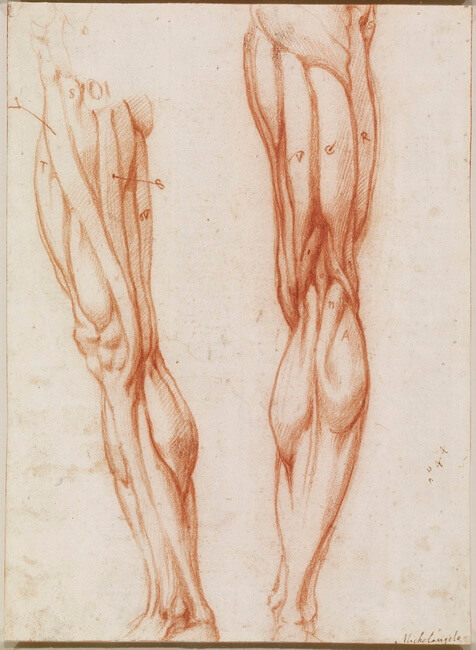
- The third unit contains the bones, joints, and muscles of the torso. These include the spine, chest, back, and abdomen.
- The fourth unit includes the bones and muscles of the skull, along with the connection and movement of its parts. This is followed by studying the facial features one by one, including the eyes, mouth, nose, and ears.
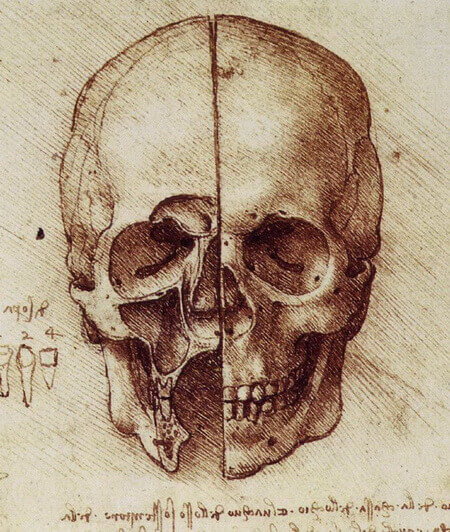
It is not enough to study artistic anatomy on a theoretical level alone. It takes a lot of practice and drawing.
Proportions of the Human Body
Knowing the proportions of the human body is essential, as is the ratio of the individual parts to the whole. Determining body proportions is about average sizes, which vary by ethnic group. Children of different ages also differ in their proportions.
Throughout the history of art, the proportions of the human body have been incorporated into various canons and modules, which have changed depending on the current ideal of beauty.
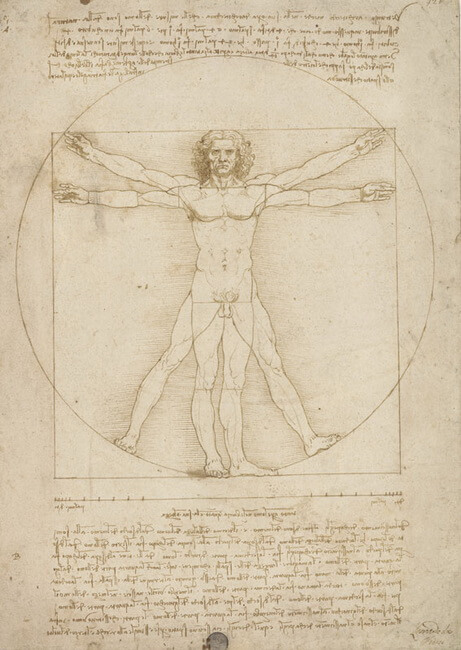
When determining the proportions of the body, we take one of its basic units: the head, the foot, or the index finger. In addition to the vertical proportions, the horizontal proportions are also important, where the differences between women and men are most visible, especially in the width of the shoulders and hips.
After performing thorough measurements, Leonardo da Vinci determined the length of the head, more precisely the face, as the base unit. His method is still used today.
The Human Body as a Whole
The human body as a whole must be studied in different poses and movements. We need to become familiar with the laws of motion and how the center of gravity changes while standing, sitting, running, or walking. You can practice this with simple gesture drawings.
Once you know the parts and the whole of the human body, you can start drawing people in action and depicting different emotions and moods.

After mastering basic anatomical knowledge, you will be able to successfully draw people based on living models or your imagination. It is also the basis for any further stylized drawing, comic, caricature, or cartoon figure.
The Development of Artistic Anatomy Throughout History
Anatomy in Ancient Greek and Roman Art
Ancient Greek and Roman sculptors closely observed the muscles on the surface of the human body and the movement of the body. Their works of art depicted perfect human bodies realistically.
Anatomy in Medieval Art
Medieval artists did not strive for a realistic, anatomically correct presentation of the human body. This is probably because the body, especially the naked, has been associated with the fall of man.
Artistic Anatomy in Renaissance Art
From the 15th century onwards, the sophisticated depiction of the body in the newly discovered antique sculptures began to influence art education. At the academies, students began to practice drawing based on antique sculptures. These sculptures are also used to illustrate anatomical books.
In Leonardo da Vinci‘s notes, we read the following opinion on the importance of anatomical knowledge: “It is necessary for a painter to be a good anatomist, so that he may be able to design the naked parts of the human frame and know the anatomy of the sinews, nerves, bones, and muscles.”
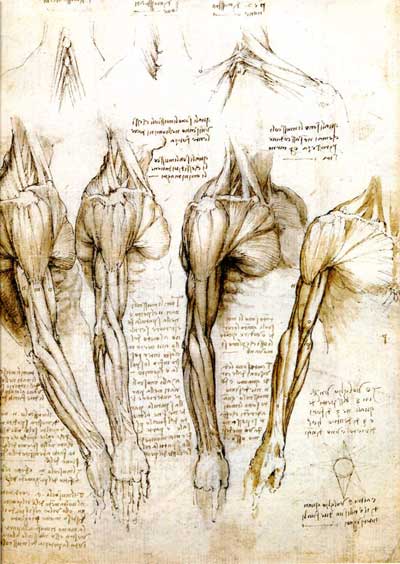
Leonardo preceded his age with his interest in anatomy. His anatomical drawings combine science and art. According to him, “the painter’s mind must of necessity enter into nature’s mind to act as an interpreter between nature and art.“
The aim of his anatomical studies, in addition to exploring bodily function, was to get to know the parts beneath the surface that were often inaccurately depicted by artists of his time.
Michelangelo Buonarroti also did anatomical research. In addition to studying live models, he also performed autopsies to learn about bone structure and the muscles beneath the surface of the skin.
German artist Albrecht Dürer (1471-1528) studied the proportions of the human body. These drawings were published by Dürer`s wife after his death. In this book, Dürer presents the diversity and variations of the human figure.
Artistic Anatomy in European Art Education (18th Century to Present)
The presentation of anatomy on living models appeared in European academies in the 1700s. Living models and plaster casts have also been used in the teaching of freehand figure drawing.
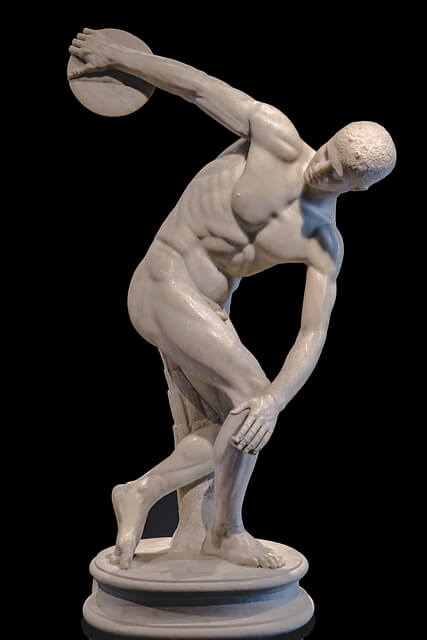
Image by djedj from Pixabay
Écorché sculptures have also become popular in anatomical education. These sculptures depicted the body without skin, showing the muscles in both a relaxed and active state.
In the post-World War II period, anatomy education at art academies in Western countries declined due to the rise of abstract and conceptual art. At the art academies in the Soviet Union, however, anatomy and figural drawing remained the foundation of academic artist training.
Gottfried Bammes has been a master of Fine Arts Anatomy in Dresden since the 1960s. With his books, he opened a new chapter in fine arts education in Western Europe.
In recent years, there has been a renewed interest in figurative art, and a rediscovery of the timeless values of ancient and Renaissance masters.
Final Thoughts
Knowledge of artistic anatomy is what makes human and animal figures lifelike and beautiful in the artworks of the old masters.
With knowledge of anatomy, you can make your drawings better, by applying constructive drawing principles, perspective, and the basic rules of composition. Without this knowledge, your drawings will look amateurish, whether you work with digital or traditional tools and techniques such as pen and ink, graphite pencils, charcoal, and dry or oil pastels.
This is why anatomy has an important place in visual arts. Learning artistic anatomy requires a lot of effort and practice, but by applying it you can raise the quality of your artwork to a much higher level.

Debora
My name is Debora, and I’m the founder of Drawing Fundamentals. I work as a civil engineering technician. I acquired the basic knowledge necessary for freehand and technical drawing during my school training, further developing and perfecting these skills throughout my years in the profession. Through my blog, I aim to assist anyone interested in learning to draw.

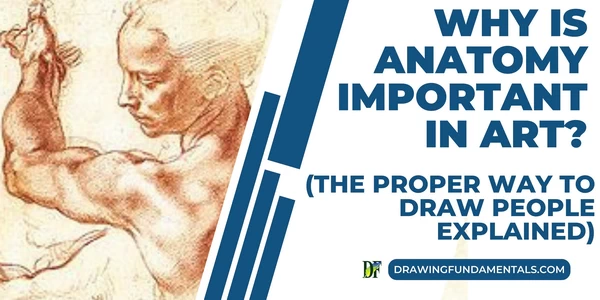
Thanks for this detailed post about artistic anatomy, it really is a very important part of learning art. I’d like to learn how to draw realistic people, but I haven’t been very successful in this so far, probably because my knowledge of art anatomy still needs a lot of improvement.
Hi, and thanks for your comment. The knowledge of artistic anatomy is really essential for drawing people. However, in order to draw successfully, you also need to learn other basic principles of drawing and practice a lot.